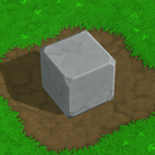Buy now
Get Version 1.1!
m (→Building) |
|||
| Line 10: | Line 10: | ||
The half brick does not require a flat surface to be built on. It will automatically flatten the area around it once placed. It only requires a one by one space for placement. This makes it ideal to fill in holes made by regular stone bricks that are too big to fit in the space. | The half brick does not require a flat surface to be built on. It will automatically flatten the area around it once placed. It only requires a one by one space for placement. This makes it ideal to fill in holes made by regular stone bricks that are too big to fit in the space. | ||
| − | Half-bricks are commonly used to fill the gaps to the right and left of doors when [staggering] brick walls. | + | |
| + | Half-bricks are commonly used to fill the gaps to the right and left of doors when [[staggering]] brick walls. | ||
 | |
| Required: | 1 Stone Brick |
|---|---|
Similar to the regular stone brick, but half the size. This allows the half brick to fit into spaces that a regular brick could not. Though it is half the size it will still cost a full stone brick to build. This means you do lose some of the stone used to make the brick in the first place. However a wall with no holes will always outweigh the extra cost.
The half brick does not require a flat surface to be built on. It will automatically flatten the area around it once placed. It only requires a one by one space for placement. This makes it ideal to fill in holes made by regular stone bricks that are too big to fit in the space.
Half-bricks are commonly used to fill the gaps to the right and left of doors when staggering brick walls.